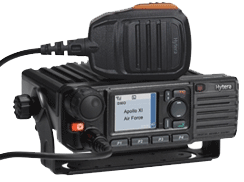Hytera DMR/Analogue Radios
For the Hytera MD-series we have a Network Interface that connects locally to the radio and gives the operator a Virtual Control Head.
You can remote control your Hytera DMR radio both in a local LAN and over the Internet. All functions programmed into the radio can be remote controlled.

Functionality
The virtual control head is fully functional with all the radios menus accessible from your PC operator position. It does not matter if the radio is used in a simple analogue one channel system or in a advanced DMR Tier3 net.
As with all other SoftRadio you can operate several radios from one dispatcher and each radio can be operated from several dispatchers. Each dispatcher can also use other types of radios in a mix.
You will find these functions:
- Remote audio and PTT
- Channel/Talkgroup change
- Presentation of channel/talkgroup with alias name
- Keys P1-P4 with short and long press
- Presentation of the radio ID of the transmitting radio in a DMR group
- Icons for; receiving, transmitting, scanning, H/L-power
- Sending and receiving SDS messages
- All the menus with contact lists, call logs etc
- Emergency
On the virtual control head there is an option to show or not to show the keyboard. If you often call radios via a numeric input, the keyboard works exactly as on the keypad microphone.
It is also possible to programme the radio so that the keyboard is used primarily for channel select. This is very practical if you have many channels in the radio, for example if it is programmed as a Marine VHF radio.
The radio can simultaneously be used both from Mimer SoftRadio and be used as a standard radio with its control head, standard microphone and speaker. (But not with a keypad microphone)
All connections are made from the rear 26 pin connector on the radio.
Network Interface: 3009/55
CableKit: 3307
Single Talkgroup use
For users that needs only one talkgroup and no other functions from the radio, the Network Interface LE can be used. A system mix of advanced radios and single talkgroup radios are also possible.
Since the connection is only made to the audio and the PTT functions, any Hytera radio can be used, not only the ones mentioned below.
Network Interface LE: 3130
CableKit: 3037
Examples of use:
- Local use when several dispatchers want to share one radio
- Remote use where a dispatcher at one location want to talk to radio users at a different location
- Cross patch between analogue radio and other two way radio, like Nexedge, DMR, Tetra or MPT
- Cross patch between VHF/UHF
A brochure can be found on the download page
Hytera MD785 connected to a Network Interface
Virtual Control Head for the MD785
Virtual Control Head shown without the optional keyboard
All the radios menues can be accessed from the
Virtual Control Head
Supported radio models:
- MD780/MD780G
- MD782/MD782G
- MD785/MD785G
- MD786/MD786G
- MD788/MD788G










